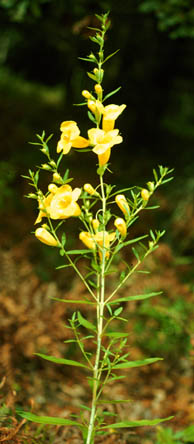
Aureolaria flava L.
by Bradley M. Jones
Environmental Soil Science
University of Georgia, Athens
E-Mail: bjones66@arches.uga.edu
Scientific Name: Scrophulariaceae Aureolaria flava L.
Common Name: Smooth False Foxglove
Synonomy: Gerardia flava L.
Plant Code: AUFL
HIGHER TAXA
Kingdom:Plantae
Class: Dicotyledenae
Order: Scrophulariales
Family: Scrophulariaceae"http://www.science.siu.edu/parasitic-plants/Scrophulariaceae.htm"=>Netscape Navigator: Scrophulariaceae Family Description
Authority: (L.) Farw.
information on higher taxo provided by:"www.fs.fed.us/ne/delaware/ilpin/342.co">Netscape Navigator: Illinois Plant Information Network
IDENTIFICATION/DESCRIPTION
Growth habit: Herbaceous Forb/Herb
Duration: Perennial
Origin: Native (a distribution map is provided on "http://plants.usda.gov/plantproj/tmp/927831443.gif"=>Netscape Navigator: National Distribution of AUFL by State
Aureolaria flava L. |
||
| AREA | STATUS | REFERENCES |
| North America: Continental United States; Canada | Yes | Bailey&Bailey, 1976 |
| Eastern North America: United States east of Mississippi; Ontario and eastern Canada | Yes | Bailey&Bailey, 1976 |
| Southeastern United States: AL FL GA KY MD NC SC TN VA WV | Yes | Bailey&Bailey, 1976 |
| Southern Appalachian States: AL GA KY MD NC SC TN VA WV | Yes | Bailey&Bailey, 1976 |
| Coastal Plain | Yes | Bailey&Bailey, 1976 |
| Piedmont | Yes | Duncan&Kartesz, 1981 |
| Blue Ridge Mountains | Yes | Duncan&Kartesz, 1981 |
| Yes | Bailey&Bailey, 1976 |
| Ridge and Valley | Yes | Duncan&Kartesz, 1981 |
| Cumberland Plateau | Yes | Duncan&Kartesz, 1981 |
| Georgia | Yes | Duncan&Kartesz, 1981 |
| Clarke County, Georgia | Yes | Duncan&Kartesz, 1981 |
The A. flava is found throughout the eastern continental U.S. from Maine and Wisconsin to S. Georgia and Mississippi. The natural habitat is in a dry forest upland (chiefly in the mountains) or a dry sandy savanna. Formerly known as Gerardia flava, A. flava grows to 4 feet high, and has oblong-shaped leaves that generally grow 4-6 inches in length in an opposite fashion. The yellow flowers (which bloom from July-October) are placed hypognously in a flower structure that is described as complete irregular. It has been advised not to pick the flowers of the genus Aureolaria for ornamental purposes. Normally these yellow flowers turn an ugly black after they have been picked.
Eleven species of North American herbs may be parasitic to the roots of Quercus, commonly referred to as oaks. Specialized structures in the roots of A. flava may penetrate the root systems of the oaks and damage them.
Another interesting detail about the A. flava species is the relationship between the iridoid glycosides in this species and Euphydryas phaeton butterflies that consume the A. flava. It was found in the Ozark region of central U.S. that the E. phaeton are the primary consumers of this species of plant, and that in doing so these butterflies are morphologically distinct from those of other regions rendering them a separate subspecies. Four iridoid glycosides were isolated and identified from A. flava and the amount was then quantified in the E. Phaeton butterflies. It was shown in an experiment conducted by Gil Belofsky et.al that butterflies who consumed A.flava acquired a certain immunity from predators who would like to enjoy them for dinner! By consuming the iridoid glycosides that are produced naturally by the A. flava these butterflies are unpalatable to birds. (Belofsky, p.1601) COOL, HUH!
REFERENCES
Bailey, Liberty Hyde, and Ethel Zoe Bailey. 1976. Hortus Third: A concise dictionary of plants cultivated in the United States and Canada. Macmillan Publishing: New York.
Belofsky, Gil, M. Deane Bowers, Sarah Janzen, and Frank Stermitz. 1989. Iridoid Glycosides of Aureolaria flava and their sequestration by Euphydryas phaeton butterflies. Phytochemistry. 28(6): 1601-1604.
Duncan, Wildbur H., and John T. Kartesz. 1981. Vascular Flora of Georgia. University of Georgia Press: Athens
Niering, William A., and Nancy C. Olmstead. 1979. The Audobon Society field guide to North American wildflowers. Alfred A. Knopf: New York.
Radford, Albert E., Harry E. Ahles, and C. Ritchie Bell. 1968. Manual of Vascular Flora of the Carolinas. University of North Carolina Press: Chapel Hill.
World Wide Web sites of interest: "http://www.fs.fed.us/ne/deaware/il/pin/342.co.htm"=>Netscape Navigator: Illinois Plant Information Network
"http://fisher.bio.umb.edu/pages/JFGenus/Jfgen26.htm"=>Netscape Navigaot: Genus of the Week>
"http://www.discoverlife.org"=>Netscape Navigaot: DiscoverLife in America
Norton-Brown Herbarium, University of Maryland, College Park, Maryland 20742-5815